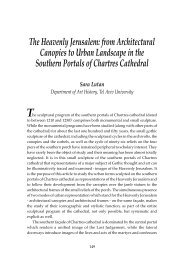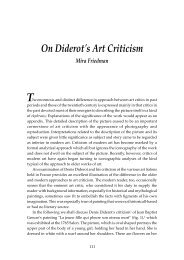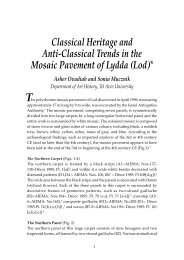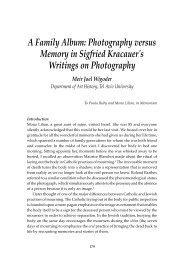The Non-presence of People in David Hockney's Paintings of ...
The Non-presence of People in David Hockney's Paintings of ...
The Non-presence of People in David Hockney's Paintings of ...
You also want an ePaper? Increase the reach of your titles
YUMPU automatically turns print PDFs into web optimized ePapers that Google loves.
THE NON-PRESENCE OF PEOPLE IN DAVID HOCKNEY'S PAINTINGS<br />
Derrida <strong>in</strong> <strong>The</strong> truth on pa<strong>in</strong>t<strong>in</strong>g, <strong>in</strong> the section that deals with Kant: ‘You have<br />
to know what <strong>in</strong>tr<strong>in</strong>sically concerns the value “beauty” and what rema<strong>in</strong>s<br />
external to your immanent sense <strong>of</strong> beauty. This requirement presupposes a<br />
discourse on the limit between the <strong>in</strong>side and outside <strong>of</strong> the art object, here a<br />
discourse on the frame’. 9 <strong>The</strong>se ornaments, cont<strong>in</strong>ues Derrida, work for Kant<br />
as <strong>in</strong>ner and outer borders. <strong>The</strong>y act as supplements - they are outside, but<br />
they are not the th<strong>in</strong>gs that are outside, because they are the borders. However,<br />
the supplement has a potential for greater importance than the work itself,<br />
s<strong>in</strong>ce without it one would not know where the creation beg<strong>in</strong>s and ends, or<br />
even the fact that one is stand<strong>in</strong>g <strong>in</strong> front <strong>of</strong> a creation.<br />
In addition to the problem <strong>of</strong> the absence <strong>of</strong> depth <strong>in</strong> the picture, discussed<br />
above, the disappearance <strong>of</strong> the body is another question that arises from those<br />
pa<strong>in</strong>t<strong>in</strong>gs. Both the water and the glass act as screens that conceal the human<br />
body: the bodies <strong>of</strong> the collectors <strong>in</strong> A Lawn Spr<strong>in</strong>kler, and the body <strong>of</strong> the diver<br />
<strong>in</strong> A Bigger Splash. In the former, the glass w<strong>in</strong>dow is simultaneously transparent<br />
- it is possible to see the armchair and other furniture <strong>in</strong>side the house, and<br />
opaque-mirror<strong>in</strong>g the outside view.<br />
Rosal<strong>in</strong>d Krauss notes that a grid [<strong>in</strong> our case the bars over the w<strong>in</strong>dows]<br />
conveys one <strong>of</strong> the basic laws <strong>of</strong> knowledge - separation <strong>of</strong> the perceptual screen<br />
from that <strong>of</strong> the “real” world. 10 <strong>The</strong> w<strong>in</strong>dow, she cont<strong>in</strong>ues, is experienced as<br />
simultaneously transparent and opaque. As a transparent vehicle, it is that<br />
which admits light - or spirit - <strong>in</strong>to the <strong>in</strong>itial darkness <strong>of</strong> the room. But if glass<br />
transmits, it also reflects. And so the w<strong>in</strong>dow is experienced as a mirror -<br />
someth<strong>in</strong>g that freezes and locks the self <strong>in</strong>to the space <strong>of</strong> its own reduplicated<br />
be<strong>in</strong>g; the bars <strong>of</strong> the w<strong>in</strong>dow - the grid - are what help us to see, to focus.<br />
Lefebvre cont<strong>in</strong>ues this l<strong>in</strong>e <strong>of</strong> thought when he speaks <strong>of</strong> a ‘double<br />
illusion’, 11 each side <strong>of</strong> which refers back to the other, re<strong>in</strong>forces the other, and<br />
hides beh<strong>in</strong>d the other. <strong>The</strong> two aspects are the illusion <strong>of</strong> transparency on the<br />
one hand and the illusion <strong>of</strong> opacity, or “realistic” illusion, on the other. In the<br />
illusion <strong>of</strong> transparency, he claims, space appears as lum<strong>in</strong>ous, as <strong>in</strong>telligible,<br />
as giv<strong>in</strong>g free re<strong>in</strong> for action. <strong>The</strong> realistic illusion is closer to (naturalistic and<br />
mechanistic) materialism. Rather than be<strong>in</strong>g mutually antagonistic, each illusion<br />
embodies and nourishes the other. <strong>The</strong> oscillation between the two, and the<br />
result<strong>in</strong>g flicker<strong>in</strong>g effect, are thus just as important as either <strong>of</strong> the illusions<br />
considered <strong>in</strong> isolation.<br />
Krauss’ argument discussed above relates also to the idea <strong>of</strong> public and<br />
private space: the 20 th century has been witness to the build<strong>in</strong>g <strong>of</strong> such private<br />
homes as “Prairie House” (1900), designed by Frank Lloyd Wright and<br />
107












